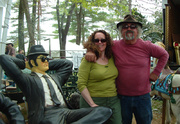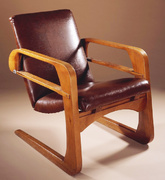
While researching her book, Killer Stuff and Tons of Money, Maureen Stanton came across all sorts of characters. For years, she shadowed her antiques-dealer friend she calls “Curt Avery,” and he gave her an insider’s view of what goes on behind-the-scenes in the antiques world—including at Brimfield Antiques Show in Massachusetts, one of the largest flea markets in the United States. Most of the dealers she met were like Avery, honest businessmen who genuinely love to share the history of objects.
“If people are enjoying these chairs as if they were real antiques, what’s the difference?”
Others were less honorable. In the book, Stanton talks about a carpenter she calls “Wesley Swanson,” who builds new Windsor chairs and goes through extraordinary measures to pass them off as valuable antiques. (An example of a rare antique comb-back Windsor chair, with writing desk, is pictured above, from Chair Blog.)
Most people have encountered a contemporary Windsor chair, as the light, easy-to-carry English design has been reproduced for centuries. But since this particular design goes back to the 1700s, the earliest Windsors fetch big bucks, selling for $3,000-$5,000 apiece. And in America, Windsor chairs were the seat of choice for the founding fathers. George Washington kept 27 Windsor chairs at Mount Vernon, while Thomas Jefferson is believed to have written the Declaration of Independence in a Windsor. When the Declaration was signed on July 4, 1776, the assembled men sat in Windsors.
With the first Brimfield flea market of the season just around the corner (May 14-19), Stanton explains how a master faker works and how he justifies joining “the dark side” in his own mind.
Collectors Weekly: How does Wesley Swanson create believable Windsor chairs?

This 18th century American bow-back Windsor armchair sold for nearly $5,000 at Skinner Auction in 2011. The chipping reveals it was painted black over red over green.
Stanton: Well, he is a master carpenter, and he’s been doing this for a long time. He also makes pottery and other ceramics as well. There’s nothing wrong with restoring an antique as long as you’re telling people you’re doing that. But he’s crossed over to the dark side, as Curt Avery says, because he’s doing this, and he’s putting a chair through auction and saying, “Well, it’s buyer beware. I don’t have to reveal this. I don’t have to label it as such because that’s the buyer’s business to know that.” He’s really, really good at what he does and he’s passing this stuff at the top houses. Obviously, I think that’s ethically questionable.
When he’s building a chair, he takes a long time and does everything very carefully. He takes perfectly green wood, and he has a way of aging it so that it’s out-of-round as if it’s aged a hundred years. He has a way of rusting up hardware. He’ll buy scraps and parts from people, or he’ll find an old piece of furniture, like another chair. And he can use the wood, nails, or hardware in the new piece that he’s making to make it look real.
But he has made an old-looking Windsor chair of 100 percent new wood. He’s developed techniques for aging paints with blow dryers and things that. It’s hard to spot the fake aging process in wood unless you X-ray it. It’s hard to tell it’s been done to the paint unless you put the chair through chemical analysis.
Collectors Weekly: Are there a lot of people like Swanson?
Stanton: He’s been a dealer for a long time, and I don’t think a lot of people know that he’s doing this now. He’s still under the radar for a lot of people. The story about him has probably put a fear of Windsor chairs into people, but it should. They should be more careful. And Swanson would say things like, “Well, if I’m restoring it to such a level that nobody can tell, not even a top expert, it’s like that philosophical question about a tree falling in the forest. If no one can tell and people are enjoying these as if they were real, what’s the difference?” That’s the mentality he’s bought into.
Master fakers are evil geniuses in their own way. I recently read a book called “The Poet and the Murderer,” about Mark Hofmann who forged the Mormon papers. But he also forged an Emily Dickinson poem and a bunch of other ephemera, such as important revolutionary times documents. The extent that he went through to make the documents look real, sucking the ink into the paper with a vacuum cleaner, is extraordinary. That’s the sort of thing that Wesley Swanson does with his woods and with his surfaces. He takes the time to age it. He won’t let it go out the door if it’s not perfect. In some ways, you have to admire his mastery in terms of his restoration. But once the piece is restored, you can’t admire how he represents it because it’s wrong.
Collectors Weekly: How can you avoid being scammed?
 Stanton: The more money you’re about to spend on an antique, the more you’ve got to be careful about knowing who you’re dealing with. At my level, it doesn’t matter if I buy something fake, because I’m not spending more than $50 or $100. But if you really are investing, and you’re going to spend $5,000 on a supposedly rare comb-back Windsor chair with a writing-arm desk, then you either ought to be expert enough to know—or know to call an expert—or you should know the person you’re dealing with.
Stanton: The more money you’re about to spend on an antique, the more you’ve got to be careful about knowing who you’re dealing with. At my level, it doesn’t matter if I buy something fake, because I’m not spending more than $50 or $100. But if you really are investing, and you’re going to spend $5,000 on a supposedly rare comb-back Windsor chair with a writing-arm desk, then you either ought to be expert enough to know—or know to call an expert—or you should know the person you’re dealing with.
I’ve heard some readers saying, “Now I’m afraid to go out and buy antiques.” It’s just like anything, like hiring a lawyer or a doctor. Ten percent of the crowd is going to be bad apples, and the rest are generally good dealers. For example Curt Avery guarantees everything. He says it’s what it is, and he guarantees it. And if someone finds out this is not what it is, he gives them their money back. But that’s never happened because he doesn’t take those chances. If you buy something and he doesn’t know what it is, he’ll say, “I think it’s this, but I don’t know,” and it’s priced accordingly. Once you buy it, you’re on your own with it, and you take the chance. A lot of dealers are like that. They have to have repeat buyers, so they have to protect their reputation.
(Read our previous interview with Maureen Stanton, “Forget TV Pickers, Meet the Real Mavericks of the Antiques World,” for more insights into Brimfield and other antiques fairs.)

 Kem Weber: The Mid-Century Modern Designer Who Paved the Way for IKEA
Kem Weber: The Mid-Century Modern Designer Who Paved the Way for IKEA
 Forget TV Pickers, Meet the Real Mavericks of the Antiques World
Forget TV Pickers, Meet the Real Mavericks of the Antiques World Kem Weber: The Mid-Century Modern Designer Who Paved the Way for IKEA
Kem Weber: The Mid-Century Modern Designer Who Paved the Way for IKEA Saving Vermont History, One Silver Spoon At a Time
Saving Vermont History, One Silver Spoon At a Time ChairsNo piece of antique or vintage furniture conveys as much personality and sa…
ChairsNo piece of antique or vintage furniture conveys as much personality and sa… Mari Tepper: Laying it on the Line
Mari Tepper: Laying it on the Line Nice Ice: Valerie Hammond on the Genteel Charm of Vintage Canadian Costume Jewelry
Nice Ice: Valerie Hammond on the Genteel Charm of Vintage Canadian Costume Jewelry How Jim Heimann Got Crazy for California Architecture
How Jim Heimann Got Crazy for California Architecture Modernist Man: Jock Peters May Be the Most Influential Architect You've Never Heard Of
Modernist Man: Jock Peters May Be the Most Influential Architect You've Never Heard Of Meet Cute: Were Kokeshi Dolls the Models for Hello Kitty, Pokemon, and Be@rbrick?
Meet Cute: Were Kokeshi Dolls the Models for Hello Kitty, Pokemon, and Be@rbrick? When the King of Comedy Posters Set His Surreal Sights on the World of Rock 'n' Roll
When the King of Comedy Posters Set His Surreal Sights on the World of Rock 'n' Roll How One Artist Makes New Art From Old Coloring Books and Found Photos
How One Artist Makes New Art From Old Coloring Books and Found Photos Say Cheese! How Bad Photography Has Changed Our Definition of Good Pictures
Say Cheese! How Bad Photography Has Changed Our Definition of Good Pictures Middle Earthenware: One Family's Quest to Reclaim Its Place in British Pottery History
Middle Earthenware: One Family's Quest to Reclaim Its Place in British Pottery History Fancy Fowl: How an Evil Sea Captain and a Beloved Queen Made the World Crave KFC
Fancy Fowl: How an Evil Sea Captain and a Beloved Queen Made the World Crave KFC
The evil geniuses of antiques! Fascinating!
Your best protection is specialist dealers, and to avoid this faker don’t buy at auction with out expert advice.
Thanks for sharing this educational article! I will certainly point our customers to this as a resource so they can protect themselves from these “master fakers.”
Hmmm, interesting stuff, but why hide his name? Expose the bastard.
aj
There are wood working craftsmen who make new Windsors and Sign their names!! The chairs are carefully and beautifully produced using harvested ,air dried and planed American woods. These beautiful chairs are usable and look historic but are signed on the bottom with the makers name.
Kurt Lewin of Capeville Virginia for instance is a fine craftsman and I am proud to own some of his pieces. One does not need to cheat people !!
Is there any markings that can tell if its a real Windsor chair
I I have two wooden chairs actually spindle chairs with a center brace in the back and at the bottom of the chair is stamped Windsor and a tag on it that reads the The home of Windsor chairs with a stamp also a number of 095–5 Nicholas and stone company Gardner Massachusetts. I hope that number is correct for it’s a little warm. I am considering re-finishing the chairs there a cherry color could you give me some information on when the chairs were made or if they have any worth to them of any value they’ve been in my mother-in-law’s house for years and she used to say to me Michael be careful of my chairs they are Windsors if you can give me some help I would appreciate it . Like what will the color be and the finish thank you. Mike
Hello,
I would like to know if D.R. Domes Windsor’s chairs are antiques and their value!
Thanks,
Marlene